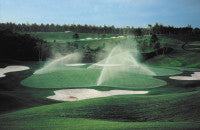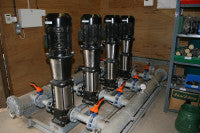What irrigation system?
 So, what irrigation system is right for you? In this fourth article in a series of six, Duncan McGilvray of EnviroPro H2O, looks at the systems currently available from the simplest forms right up to computerised systems
So, what irrigation system is right for you? In this fourth article in a series of six, Duncan McGilvray of EnviroPro H2O, looks at the systems currently available from the simplest forms right up to computerised systems
I will purposefully steer clear of naming manufacturers and trade names - generally you get what you pay for, which is the same when you buy anything. If you do need to make choices speak to colleagues who have or still use the products - there is nothing like first hand recommendations from someone within your own profession.
My own experience tells me to go for the simplest system available so that you will always feel in control, but this may turn out to be very labour intensive, as well as being wasteful in water, so do not discount the most up to date computerised systems. They may be much more cost and usage effective in the long term.
The history in general
Watering of sports areas started a very long time ago and mostly comprised of a hand held hose and rose or even a squashed bit of pipe clipped to the end of the hose to resemble rainfall as closely as possible. In extreme cases bowsers, watering cans and even calling out the local fire brigade have been used to try to keep grass alive in times of severe drought.
It quickly became apparent that a person standing on the end of a hose was not very efficient or cost effective (except when fighting fires!), and so, various forms of substitute became available.
Surface standing moveable sprinklers were the most popular for a time and were very successful in their day when there were few players in evidence. With more leisure time came more players, and they played when we wanted to irrigate causing interference and inconvenience. Sprinklers were switched off and/or moved by interfering players so this became a management nightmare for groundstaff. Nobody was happy - worker or player.
On some sports grounds there was no need to simulate rainfall so a good soaking from time to time was all that was required. Water filled hoses with holes punched in them were widely used with great success. In fact, some still use this method to very good effect.
Watering through the night was then considered as a solution to the interference and inconvenience factor. That involved a night shift to watch, move and adjust the standing sprinklers by handto ensure an even coverage. Watering at night is by far the best way to irrigate because of much lower evapotranspiration rates but staffing level requirements could not justify the costs involved.
Some dedicated souls even worked through the night watering and then continued to do a full day's shift on everything else that needed doing to ensure good playing surfaces; and for no extra remuneration. This could not continue for very long without dire consequences.
So, along came the first 'invisible' pop-up systems in the mid to late 1960s.
The 1960s till now - 'invisible irrigation systems' Although most people envisage all underground irrigation systems to be very similar they can range from simple pipework and taps operated manually, to very complex, accurate, computer controlled, infinitely variable, fully automatic, remote controlled systems.
For the purpose of clarity we cannot go into every detail so we will concentrate on the basics and you can then work out which system would best suit your needs.
Whether to use mains or other sources of water was covered in a previous article.
Generally, anything other than hydrant points and hoses require pressures well in excess of the normal mains supply. Therefore, a requirement for the inclusion of an electrically operated pumping facility is necessary.
This gives me the opportunity to describe the very latest in pumps - they are now intelligent! - they measure the amount of pressure/flow of water required and ask for the right electrical supply to start the pump - it therefore starts very slowly and smoothly (none of that big 'clunk' on start up) and only runs at the rate which is required.
The benefits of 'intelligent' pumps are many:
• They use less electricity to power so are much more energy efficient
• They are put under much less stress so are much more reliable and will therefore last longer
• They have infinitely variable speed so are much, much quieter
• They qualify for the enhanced capital allowance scheme
• They will accurately maintain the set system pressure from zero flow to pump maximum
The irrigation systems available are:
• Hydrant points and hand held/variable hoses - Why not if it serves your needs? - I believe, howeve,r that the only areas where they can be deemed to be successful are cricket wickets
• Underground pipework with manually operated instant or timed valved pop-ups - This can be sufficient for small set ups where staff have the time to manually switch on or adjust timers to suit the areas to be watered. Generally though, it is not very efficient and is not a good use of the labour available. Calling in at night is often called for because of unreliability
• Automatically operated pop-ups with electro-mechanical control - Most prevalent in the early years of automatic pop-up systems, deemed not to be very accurate, dealt in 1 or 3 minute periods so not very precise but very much the forerunner of all the systems which exist today. Reliability of the control unit has made a lot of these controllers obsolete - we still see one or two of them about but they are very rare because of the problems encountered
• Automatically operated systems with computerised controls -The first computerised systems and commonly referred to as 'the box on the wall'. Still very much in evidence and certain makes are still very reliable. As a golf course manager I was responsible for two such systems being installed at different golf clubs, which are still being used today more than 25 years later. We are often asked if we can still get a hold of such control systems and the answer is yes as there are some manufacturers who have seen a need and are producing new, simple 'box on the wall' controllers to suit customer preferences.
• Automatically operated systems with computerised controls - PC based - This is where most believe we should all be heading and not just for the very few who have large budgets and vast sports areas. I have to, and must agree, and not for purely commercial reasons. The most important environmental consideration is water usage - how much is used and where it is used.
The only way to irrigate efficiently, effectively and accurately is by using computers to measure, record and define areas where water is required so that water is not wasted.
It is very difficult to argue against that viewpoint and, therefore, it seems to me that computerised system are inevitable for all in the future - it just makes environmental sense.
Duncan McGilvray, Managing Director
Enviropro H2O Limited
